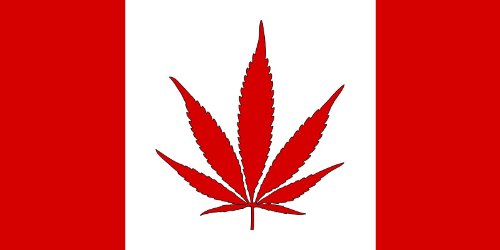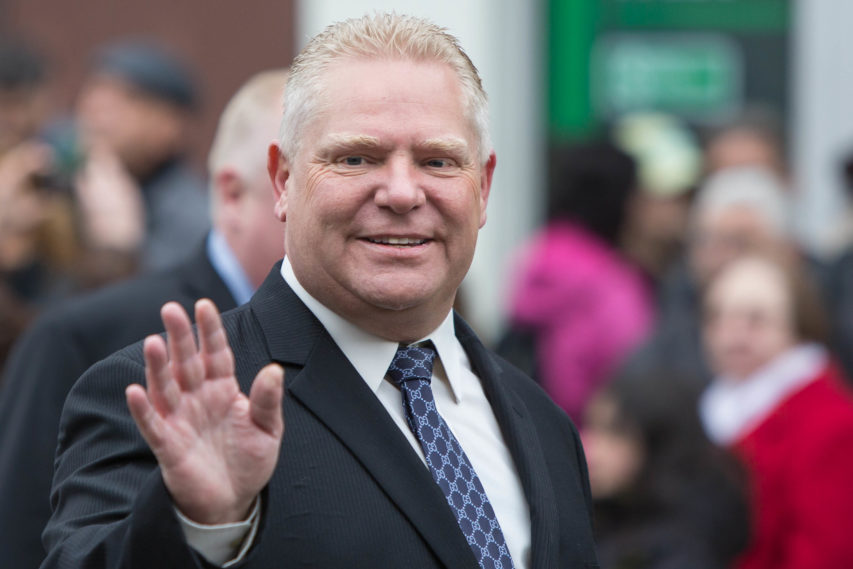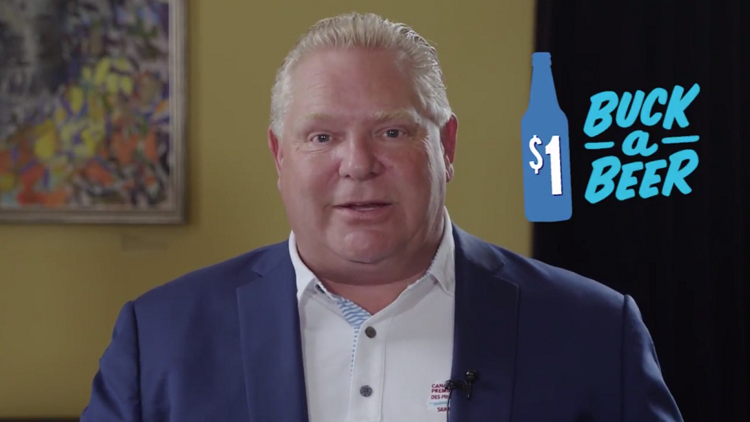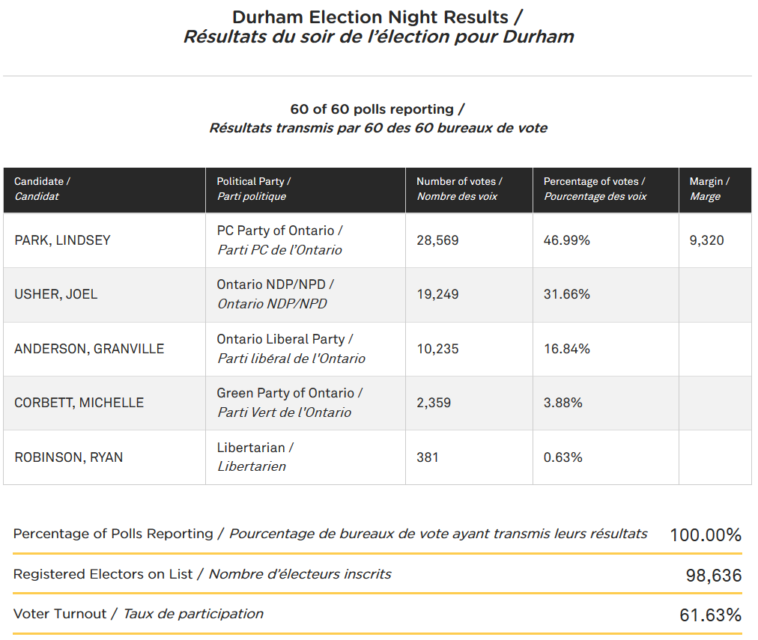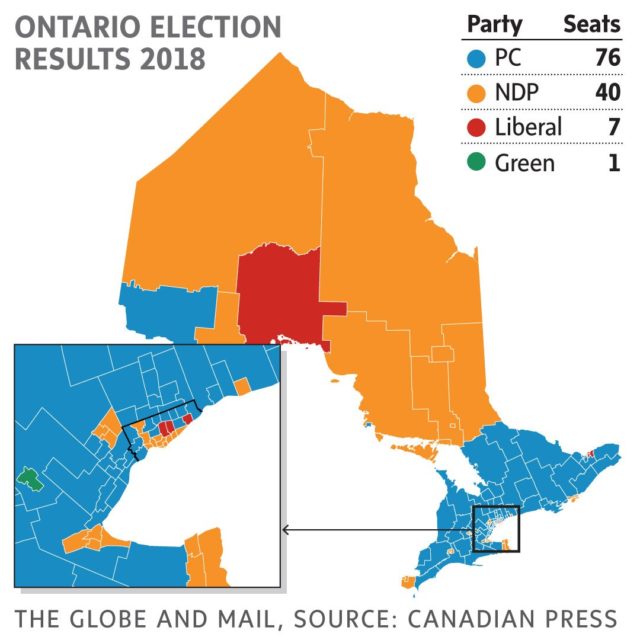There’s that word: “investments.” That’s what Canadians — Ontarians and Quebecers, certainly — have been trained to expect in these situations: An elaborate mating dance culminating in a greasy press conference where corporate leaders hail bold new provincial and federal “investments” in the company and its workers and its world-beating widgets. Critics are assailed as uncaring and testily reminded that every jurisdiction subsidizes the widget industry.
Traditionally, this is later followed by outrage when it emerges the company has used taxpayers’ bold investment to pay out lavish bonuses or dividends. In the fullest version of the performance, the company just pulls up stakes and leaves town anyway — sometimes having fulfilled its stated obligations, sometimes not, but always leaving behind a bad taste and a per-employee subsidy rate that makes no sense in hindsight.
If the company is Bombardier, it might extract lavish subsidies from government for an airplane project on the theory the Canada needs an aerospace industry, then turn around and sell the project to a foreign competitor for basically nothing.
Chris Selley, “A reminder that governments don’t ‘invest’ in businesses. It’s just corporate welfare”, National Post, 2018-11-28.
December 19, 2018
QotD: Maple-flavoured corporate welfare
November 22, 2018
The apparently unexpected backlash over cancelling a French-language university in Ontario
I suspect a lot of the uproar is actually just target-of-opportunity stuff to justify criticism of Ontario premier Doug Ford. Chris Selley points out that until the announcement, there wasn’t actually a lot of support for the new university among French-speaking Ontarians:
You would never know it since Thursday, when the Ontario government cancelled plans to open a new French-language university in Toronto, but those plans were not universally beloved. A lot of people hated the location. In an op-ed in Le Droit, University of Ottawa political scientist François Charbonneau complained it was being built to serve future francophone immigrants, not proper Franco-Ontarians in a community where they’ve been established for generations.
He called it “a historic mistake that perfectly illustrates what it means to be a minority: to have no power over one’s own destiny and to be dependent on ideological rantings with no democratic legitimacy.”
Higher-education consultant Alex Usher was among many who dismissed enrollment projections for the university as “fantasy.” Writing on the Higher Education Strategies blog, Usher called a recent survey of francophone Ontario high school students the “worst piece of social science I have ever seen.” It found lots of interest in attending the new university, but didn’t bother asking about their interest in existing bilingual alternatives like Laurentian University and the U of O.
To language hawks, bilingualism is the enemy: French always loses out in a budget crunch, and it does nothing to advance the right to live one’s life solely in French. Trouble is, very few students at French-language Ontario high schools are remotely interested in living their lives solely in French.
These are all things Premier Doug Ford and his ministers might have mentioned if they hoped to leave an impression other than that Ontario francophones just aren’t worth the money. They might wisely have chosen not to axe the French Language Commissioner in the same fiscal update, transferring its complaint-resolution powers to the ombudsman but orphaning its advocacy mandate. Finance minister Vic Fedeli hasn’t even said how much of its $1.2 million budget he hopes to recoup.
But they did what they did, all at once, and they said it was all about saving money. I suspect the whirlwind they reaped came as a surprise.
Good heavens, though, what wind.
November 20, 2018
Gordon Lightfoot’s “Wreck of the Edmund Fitzgerald“
Mark Steyn devotes a column to the work of Canadian singer/songwriter Gordon Lightfoot, particularly his very well-known ballad on the loss of the Edmund Fitzgerald on Lake Superior in 1975:
When it comes to trains and boats and planes, Gordon Lightfoot has hymned all three, but it’s the middle mode of transportation that produced the song he’s proudest of:
The ship was the pride Of the American side
Coming back from some mill in Wisconsin
As the big freighters go
It was bigger than most
With a crew and good captain well seasoned…In November 1975 Lightfoot chanced to be reading Newsweek‘s account of the sinking of a Great Lakes freighter in Canadian waters. He’s a slow and painstaking writer, which is one reason he’s given up songwriting – because it takes too much time away from his grandkids. But that day forty-three years ago the story literally struck a chord, and he found himself scribbling away, very quickly:
The legend lives on From the Chippewa on down
Of the big lake they called Gitche Gumee
The lake, it is said Never gives up her dead
When the skies of November turn gloomy…“Gitche gumee” is Ojibwe for “great sea” – ie, Lake Superior – as you’ll know if you’ve read your Longfellow, which I’m not sure anyone does these days. Evidently Hiawatha was on the curriculum back east across Lake Huron in young Gordy’s Orillia schoolhouse. The Gitche Gumee reference may be why, when I first heard “The Wreck of the Edmund Fitzgerald“, I assumed its subject had sunk long before the song was written. In fact, it sank on November 10th 1975 – just a few days before Lightfoot wrote the number. When she’d launched in 1958, the Edmund Fitzgerald was the largest ship on the Great Lakes, and, when she passed through the Soo Locks between Lakes Superior and Huron, her size always drew a crowd and her captain was always happy to entertain them with a running commentary over the loudspeakers about her history and many voyages. For seventeen years she ferried taconite ore from Minnesota to the iron works of Detroit, Toledo and the other Great Lakes ports …until one November evening of severe winds and 35-feet waves:
The wind in the wires
Made a tattle-tale sound
And a wave broke over the railin’
And every man knew
As the captain did too
‘Twas the witch of November come stealin’…And about seventeen miles from Whitefish Bay the Edmund Fitzgerald sank, with the loss of all 29 lives. It remains the largest ship ever wrecked on the Great Lakes, launched in 1958 to take advantage of the new St Lawrence Seaway (to be opened by the Queen and President Eisenhower on an inaugural voyage by the Royal Yacht Britannia the following year) and specifically constructed to be only a foot less than the maximum length permitted. Edmund Fitzgerald was the then chairman of Northwestern Mutual Life Insurance of Milwaukee, and, as far as I’m aware, the only insurance company executive to be immortalized in a song title. Fifteen thousand people showed up for the ship’s launch at River Rouge, Michigan. It took Mrs Fitzgerald three attempts to shatter the champers against the bow, and then there was a further half-hour’s delay as the shipyard workers tried to loosen the keel blocks. After which the ship flopped into the water, crashed against a pier, and sent up a huge wave to douse the crowd. One spectator promptly had a heart attack and died.
And then came seventeen happy years. Even in the twenty-first century, there is something especially awful and sobering about death at sea: it is in a certain sense a reminder of the fragility of security and modernity. Whenever I’m in, for example, St Pierre et Miquelon, the last remaining territory of French North America, I stop by the monument aux marins disparus, sculpted in 1964 and to which many names have been added in the years since – because a ship put out, and somewhere on the horizon the great primal forces rose up from the depths and snapped it in two like a matchstick.
October 31, 2018
Premier Ford’s promise to lower electricity rates in Ontario
In the Financial Post, Lawrence Solomon says Doug Ford can’t risk abandoning his promises about Ontario electricity costs, despite his cabinet’s worries about provincial reputation damage:
Ford has every reason to return the power system to some semblance of economic sanity. Ontario is now burdened by some of the highest power rates of any jurisdiction in North America, throwing households into energy poverty and forcing industries to close shop or move to the U.S. The biggest reason by far for the power sector’s dysfunction is its renewables, which account for just seven per cent of Ontario’s electricity output but consume 40 per cent of the above-market fees consumers are forced to provide. Cancelling those contracts would lower residential rates by a whopping 24 per cent, making good on Ford’s promise to aid consumers.
[…]
To date, Ford has stopped renewable developments that haven’t been completed, which will prevent things from getting worse, but he has failed to tear up the egregious contracts of completed developments, which will prevent things from getting better. Based on conversations that I and others have had with government officials, it appears that Ford is inclined to cancel the contracts and honour his signature promise, but he is being thwarted by cabinet colleagues who fear that Ontario’s reputation will take a hit in the business community if they don’t play nice.
Except, there’s nothing nice about betraying a promise to the voters who democratically put you in power in order to avoid pressure from lobby groups who think governments are entitled to hand out sweetheart deals to their favoured cronies. There’s also nothing democratic about it. It is an axiom of parliamentary government that “no government can bind another.”
Canadian governments, including Ontario governments, have in the past torn up odious contracts, including those in the energy sector. When they did, upon passing binding legislation, they were able to reset the terms, offering as little or as much compensation as they wished. Outraged business lobbies’ claims that the reputation of governments would be affected were not borne out. Moreover, such rightings of political wrongs serve the interest of small government and free markets, because businesses have always understood that there’s an inherent risk in contracting with governments that are able to unilaterally rewrite contracts. To overcome that inherent risk, businesses add a risk premium when getting in bed with government, helping to explain the rich contracts the renewables developers demanded. That risk premium acts to make business-to-business dealings more economic than business-to-government dealings.
October 19, 2018
Ontario’s lack of retail cannabis stores – “What have they been smoking at Queen’s Park?”
In the Financial Post, William Watson points out the weirdness of Ontario’s decision to delay the opening of legal cannabis stores until next Spring:
For several years now, dozens of dispensaries have been operating quite openly. (They call themselves dispensaries to further the narrative that, like your grandmother’s rye, marijuana is for medicinal purposes.) Only now, with pot use becoming legal, are these dispensaries being shut down — although Toronto’s chief of police says not right away, as he doesn’t have [the] person power to do it all at once.
If they don’t shut down, they may forfeit their chance at a licence to sell pot legally once licensed retail operations do finally start in the province on (when else?) April 1st of next year — 166 days after legalization. Why would they not be granted a licence? Not because they trafficked in marijuana when its use was strictly illegal, if seldom prosecuted. But because they continued to traffic in marijuana after it became legal but before the government gave them a licence, an offence that will be prosecuted slowly, if at all.
Silly me. I thought marijuana legalization would simply say that after a certain date the police wouldn’t arrest you for having such-and-such an amount of marijuana in your possession. End of story.
[…]
Countrywide, as the Financial Post’s Vanmala Subramaniam recently reported, a big roadblock to timely legal supply has been the need to seal products with federal excise revenue stamps. But there’s only one supplier and the stamps come without adhesive. Stamps! In 2018!
In American movies of the 1930s and 1940s, moonshiners and bootleggers waged war against “revenuers,” federal agents charged with levying excise taxes on booze. It seems the revenuers have now taken charge of Canada’s marijuana industry. You might plausibly argue that the former illegal market operated in the interests of consumers. There seems little doubt the new legal market will operate in the interest of governments, their unions and their revenue departments.
When cops did enforce the country’s no-toking laws, they could plausibly tell themselves they were doing it to protect young people and other innocents. Now when they enforce the laws they’re doing it to protect legally privileged producers against producers who find themselves offside with often arbitrary licensing laws. Protecting kids was one thing. Protecting cartels is quite another.
October 17, 2018
How Toronto got its name
Colby Cosh on the origins of the name of Canada’s largest city (which, surprisingly, isn’t the Mississauga name for “big stink on the water”):
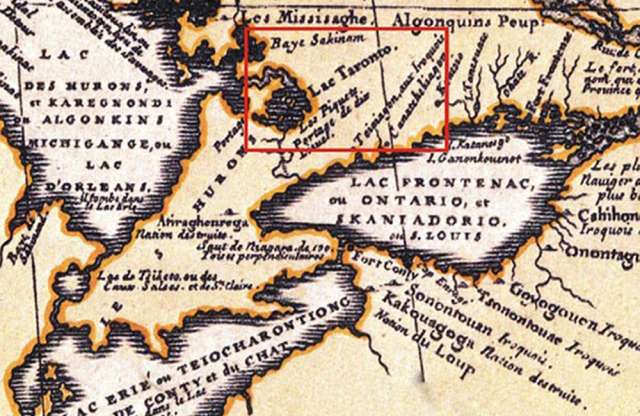
Detail from a 1688 map of western New France by Vincenzo Coronelli that locates “Lac Taronto” at Lake Simcoe.
City of Toronto Culture Division/Library and Archives Canada via the National Post
By the time of Franquelin, “Tkaronto” had already become “Taronto,” a generic name for the highway between Lake Simcoe and Lake Ontario. The Humber River was called the Toronto River by the French before Gen. John Graves Simcoe and the British got hold of everything. The word, in turn, became attached to a trading settlement at the southern end of the trail — a pretty crummy place, by all accounts, but one destined for bigger things as part of a global seafaring empire.
The miracle is that it held on to the name. Simcoe insisted that “Toronto,” on being anointed as the site of the new capital of Upper Canada in 1793, be dubbed “York” in honour of Prince Frederick (1763-1827), Duke of York and second son of George III. This Duke of York is the “Grand Old Duke of York” from the satirical verse about military futility. He was also commander-in-chief of the British armies that helped to chase Napoleon out of Europe twice, and is thought to deserve genuine credit for this, so be careful who you write insulting rhymes about.
Simcoe dubbed Toronto “York” just because he was sucking up to a very identifiable future boss, and for no other reason. The people of Toronto seem to have understood this and resented it. In the decades to come, it was occasionally observed that there were something like a dozen other places in Upper Canada called “York.” Moreover, Simcoe’s “Little York,” as it was often called, seems to have presented an increasingly embarrassing parallel with the Americans’ bustling New York.
In 1834, when the Legislative Council of Upper Canada decided that the capital needed to be formally incorporated as a city, the citizenry remembered that they belonged to “Toronto” and appealed to the council to have the more musical old name restored. Over four decades their annoyance had not receded. Diehards who wanted York to remain York for imperial-grandeur reasons were outvoted, and Toronto’s formal Act of Incorporation observes that “it is desirable, for avoiding inconvenience and confusion, to designate the Capital of the Province by a name which will better distinguish it.” The appellation “Toronto,” of course, had actually been nicked from a spot some way off, but the white settlers had mislaid that information, and didn’t check with anyone who would know better.
October 5, 2018
A quick way for Doug Ford to reduce Ontario’s electrical rates
Ross McKitrick, Elmira Aliakbari and Ashley Stedman outline one of the fastest ways for the Ontario government to get Ontario electricity rates back down toward the national average:
The Ford government seems to want to repair Ontario’s electricity market. It recently moved to scrap the Green Energy Act and reportedly plans to eliminate or alter the so-called Fair Hydro Plan.
While these moves will mitigate future price increases, they won’t reduce current electricity prices. In fact, according to a Fraser Institute study being released today, to lower existing prices the government must reduce what’s known as the “Global Adjustment” — an extra charge on electricity. It won’t be easy, but reducing the global adjustment could bring down electricity prices by about 24 per cent.
This would be welcome news for Ontarians, as electricity prices increased 71 per cent from 2008 to 2016, far outpacing electricity-price growth in other provinces.
[…]
Between 2008 and 2017, the GA grew from less than one cent per kilowatt-hour (a common billing unit for energy) to about 10 cents, accounting for the entire increase in Ontario electricity commodity costs over that time. Therefore, the key to lowering power prices in Ontario is to reduce the GA.
In our study, we use reports published by the Ontario Energy Board to breakdown the GA to better understand where the money goes and provide specific recommendations on how to lower electricity prices. We found that the largest component of the GA charge — nearly 40 per cent — funds subsidies paid to renewable energy sources (wind, solar, etc.) under feed-in-tariff contracts, yet these sources only provide seven per cent of Ontario’s power output.
And notably, the GA provides almost 90 per cent of revenue earned by renewable generators, with only 10 per cent coming from actual power sales. This overwhelming reliance on government subsidies (paid by ratepayers) rather than actual electricity sales reveals how distorted the pricing structure has become in Ontario.
September 29, 2018
The Ontario government’s amazingly sensible approach to legal cannabis
Chris Selley expresses what a lot of surprised people must be feeling after Premier Doug Ford’s government introduced startlingly mature and sensible rules for the distribution and sale of cannabis products in the province after the federal government’s legalization is enacted:
The Ontario government tabled its cannabis retail framework in the legislature on Thursday, and it only further repudiates the Frightened Communist model envisioned by the Liberals. The government will sell pot online, as before, and will maintain a monopoly on wholesaling. But the rest will be up to the private sector, under the control of the Alcohol and Gaming Commission. As it stands, there won’t even be a cap on the number of licences; a government official said Thursday they expect 500 to 1,000 applications right off the bat.
In response, OPSEU president Smokey Thomas beamed out a furious press release on behalf of his spurned members — er, sorry, on behalf of Ontario’s “municipalities and communities.”
“Unlimited stores and unlimited places to smoke will cause unlimited problems,” Thomas averred. “It’s outrageous. We’re going to become the wild west of cannabis and Sheriff Doug Ford is going to skip town, leaving communities and municipalities holding the dime bag.”
Thomas predicted Premier Ford would hand out retail pot licences to “Conservative insiders” and “corporate donors.” (Corporate donations are illegal.) He accused Ford of funnelling what by rights should be public profits into “private pockets.”
“If Ontario’s finances are truly as bad as Ford wants us to believe, why is he giving away the millions, maybe even billions, in revenue we’d get if cannabis sales were public?” he asked.
Does the government make money on cigarettes? On alcohol sold in bars and restaurants, at privately run LCBO agency stores and, of late, in supermarkets? Of course it does. Scads of it.
So it’s all quite ridiculous, as OPSEU press releases tend to be. But Thomas is not wrong when he argues the new approach is remarkably permissive. Perhaps most notably, whereas the Liberals’ proposed rules banned using marijuana in public, the PCs’ would allow you to smoke or vape it anywhere you can tobacco (though not in cars or boats). But it’s far less permissive than one might expect in other ways as well.
September 28, 2018
Ontario government lays out the path to a fully legal cannabis market
There is going to be a gap between the federal legalization date next month and the beginning of legal sales from brick-and-mortar stores in Ontario in April:
With the legalization of recreational marijuana around the corner, the Ontario government has finally answered some of the most burning questions about where residents can officially buy and smoke pot.
A day before new pot legislation is set to be tabled, The PC government announced earlier today that starting Oct. 17, weed will be up for sale at private retail pot shops by April next year.
Doing away with the cap on the number of licensed cannabis stores in the province, the government is officially taking a free-market approach to what would previously have been an LCBO monopoly under the Liberal provincial government.
[…]
Until April, cannabis will be sold exclusively online, distributed through federal wholesalers and the government’s Ontario Cannabis Store.
The Alcohol and Gaming Commission of Ontario will be in charge of regulating the marketplace, including granting and revoking pot shop licenses.
Store owners will need to apply for a retail-operator license as well as a retail store authorization for every location they open, which will be limited to a set number, to prevent possible over-expansion, Walmart-style.
There will also be restrictions for federal cannabis growers, who will only be able to hold “a single retail license at a single production site located in Ontario,” said Ontario Attorney General Caroline Mulroney.
All currently existing pot stores who continuing to operate illegally after Oct. 17 will lose their right to ever apply for a license in the future, as will stores who have a history of dealing with organized crime and providing pot to minors.
Ontario’s new government agency, the Ontario Cannabis Retail Corp., will be in charge of handling online cannabis sales as well as wholesaling to private stores, who will potentially run the gamut from local pot shops to huge cannabis corporations.
There will be a minimum distance requirement between pot shops and schools set up in the future.
Any Ontario municipalities who don’t want pot shops on their turf — like Norfolk County in Southwestern Ontario, the first to vote no on cannabis storefronts — will have to opt out officially by Jan. 22, 2019, which they were previously barred from doing.
September 21, 2018
Doug Ford is a bit like Trump in the way he gets his critics to froth and fizz on demand
For all the claims that Doug Ford would be “just like Trump”, they’re not all that similar, but one way the Ontario Premier does resemble the American President is the way that they both can send their opponents into rhetorical hysteria almost without effort:
As much as Ford’s government has violated political norms, we shouldn’t want the remedy to do likewise — whether it’s the feds invoking Disallowance (as a majority of Toronto city councillors voted to support) or the Lieutenant-Governor refusing Bill 31 Royal Assent (as requested Tuesday by various petitioners led by former lefty Toronto mayor John Sewell), or a judge undermining provincial authority over municipalities on grounds that collapse in higher courts.
So now, perhaps, Toronto can return to reality — or as close as you can get during an election campaign.
No, there was no magic brand of fit Mayor John Tory or hypothetical mayor Jennifer Keesmaat or anyone else could have pitched that would have stopped Ford in his tracks. Torontonians’ fits are a feature for Ford, not a bug. In defending Bill 5 he has repeatedly namechecked various left-leaning allegedly do-nothing councillors. Their apoplexy sustains him. In his book about Rob Ford, councillor John Filion quoted Doug Ford on his plans for Tory after losing the 2014 mayoral election: “He’s going to take off the sheets in bed at night and find my teeth wrapped around his nuts.”
Note that Chris Selley is careful to include the “allegedly” there … no need to invite lawsuits for the National Post.
And no, there is no real hope of relief in the ongoing appeals process over Bill 5. Even if the Supreme Court were to side with Belobaba, it would only repudiate the way in which the province wielded its powers — i.e., in the middle of an election — not the powers themselves. Had the government waited four years, or even legislated a two-year council term at 47 wards to be followed by an election at 25, it would have been on plenty-thick ice. It could easily re-legislate a 25-ward Toronto after such a ruling, and without using the notwithstanding clause.
Toronto politicians are destined to be Doug Ford’s favourite punching bag at least until they stop reacting so hysterically every time he so much as looks in their direction. He may not be a Twitter troll of the same mastery as Donald Trump, but he doesn’t appear to need social media to get his critics all panty-bunched.
Similarly, while there is no telling how much Ford might meddle in Toronto’s affairs in the coming years, at every step along the way he will make the idea of meddling in Toronto affairs more toxic for future non-Conservative governments. All provincial governments have screwed over Toronto now and again; as of this summer, screwing over Toronto is Something Doug Ford Does. And no Liberal or New Democrat wants to be like Doug Ford.
When things die down a bit, the opposition parties will have to take a break from denouncing Ford and explain what they’ll do in future to strengthen Toronto’s democracy: restore control over its political boundaries, provide more taxation powers, allow road tolling, whatever. It would be Pollyannaish to suggest Ford has caused a political awakening in Toronto, but he has certainly made it more attractive for the other parties to take Toronto more seriously, and concurrently much more risky for them to be seen reneging on such promises in future.
August 31, 2018
Farewell, buck-a-beer publicity stunt, we hardly knew ye
Chris Selley on the all-too-brief publicity stunt of cheaper beer for Ontario:
President’s Choice is ending its buck-a-beer promotion on Sept. 3, just days after it started: We get one week, one long weekend and then out of the pool, party’s over, back to class. PC-branded beer will rocket back up to $1.38 a bottle when you buy 24 at The Beer Store or $1.65 when you buy 12, which highlights just how steep — and presumably unsustainable — the discount really was. We shall see how long the two other participating breweries’ offers last, but they made it quite clear, as did PC, that this was a limited-time offer prompted by Doug Ford’s most shamelessly blunt populist pledge.
My goodness, though, what a commotion it will leave in its wake. Some brewers quite understandably took the opportunity to note the impact of aluminum tariffs on their bottom lines, to complain that Ford’s government was playing favourites by giving away expensive product placement in LCBO stores for $1 beer, and to note the government is actually raising taxes on beer.
Others, however, waxed utterly scandalized. “How about buck a pound of steak? Who would eat that?” asked one Toronto brewer who had perhaps not entirely thought through his rhetorical question. “We haven’t even given two thoughts about this,” Great Lakes Brewery’s communications manager, Troy Burtch, told the Toronto Star. “Why would anyone do this?” Burtch and Great Lakes have signalled their total uninterest by tweeting incessantly about it.
The Canadian Taxpayers’ Federation went after some of the affronted craft brewers for accepting taxpayer subsidies for their higher-end products. People on social media lined up for and against buck-a-beer, vowing to boycott the participants or those complaining about the program.
The whole thing was a dumb Ford Nation stunt, no question. But good grief. You can hardly blame the breweries, either for participating or for not: they were just trying to wring as much publicity as they could from the situation. No one is really any worse off, or at least not much. What we were really seeing among the chattering classes was a rerun-by-proxy of the June 6 election: to drink Ford’s swill was to vote Ford Nation; to boycott it was to stand bravely against their entire agenda.
August 14, 2018
Ontario embraces online sales for marijuana, with retail stores to follow in 2019
Chris Selley on the Ontario government’s surprisingly sensible approach to phasing in retail sales of cannabis over the next eight months:
Ontario’s Progressive Conservative government called a brief truce in its multi-front war with the federal Liberals on Monday to give one of Prime Minister Justin Trudeau’s signature policies a major boost: as had been widely rumoured, the Tories will scrap the previous Liberal government’s tentative public marijuana retail scheme and instead hand out licenses to the private sector.
How many licenses and what kinds of stores are just two of many unresolved details. The government says it will consult widely to determine how best to proceed, with a target opening date for licensed brick-and-mortar stores of April 1, 2019 (with publicly run online sales to commence in October). But it seems safe to hope the cap, if any, will be significantly higher than the previous government’s laughably timid 150.
Thanks to Toronto’s reluctantly laissez-faire approach to illegal storefront (nudge-wink) “medical” marijuana “dispensaries,” we know 150 might not even satisfy a free market in the country’s largest city. Trudeau has always said the goal of legalization was to smash the illegal market and plunk down a legal one in its place. The Ontario Liberals’ plan seemed almost tailor-made to fail in that endeavour.
There remains ample room for the new government to screw this up. But if it gets pricing and regulation and enforcement halfway right, the country’s most populous province should now be well placed to give legalization a good shot at achieving what proponents have always said it should — which is, basically, to make it like booze. Of course kids still get their hands on booze, but at least it’s a bit of a chore. And at least when kids get drunk, they’re not drinking moonshine.
The need to claim the retail market from the existing extra-legal networks will hinge on quality, availability and (especially) the prices that the province sets. Price it too high (pun unintentional), and the legal market will not take over distribution and sales from the black market. Provide poor quality and get the same results. Restrict sales too stringently, and watch the profits go back to the current dealers … who are not noted for their sensibilities about selling drugs to the under-aged.
In the meantime, it’s interesting to ponder why they’re going in this direction. Fedeli and Attorney-General Caroline Mulroney were at great pains Monday to stress their primary concern was the children.
“First and foremost, we want to protect our kids,” said Mulroney. “There will be no compromise, no expense spared, to ensure that our kids will be protected following the legalization of the drug.”
“Under no circumstances — none — will we tolerate anybody sharing, selling or otherwise providing cannabis to anybody under the age of 19,” said Mulroney. Fedeli vowed that even a single sale to a minor would void a retailer’s license.
Yet, let’s be honest, kids well under the age of 19 can already get cannabis and other illicit drugs — more so in urban and suburban areas, but it’s hard to imagine that legalizing cannabis for 19-plus customers somehow magically renders the under-19s uninterested in getting access, too.
July 5, 2018
Barbara Kay on revising Ontario’s sex-ed curriculum
Her latest column in the National Post has some advice for Premier Doug Ford and his merry band of (dare I say) reformers:
Doug Ford’s victory was in some measure due to his promise — I believe a heartfelt one — to repeal the sex ed curriculum in Ontario schools. I assume there’s a replacement program in the works. A sex-ed vacuum is not politically tenable, or even what most conservative parents want.
What principles will undergird a Doug Ford inspired curriculum? I’d suggest four guidelines for his consideration.
First, take sex ed out of the hands of ideologues and activists. Constitute a task force made up of a variety of stakeholders, involving both liberal and conservative parents (including parents of LGBT students), disinterested scientific authorities and, yes, religious representatives, to hammer out recommendations for a sex ed paradigm, in which science is separated from theory, and in which proponents of morality and modesty-based sex ed have a voice and a vote.
Second, revisit the underlying premise in sex ed today that all children must learn everything under the sun that touches on sexuality from the state.
[…]
Third, there is the question of readiness. Children can be taught the facts of biology quite early, but there is no need to engage young children in detailed discussion of sexual preferences before they fully understand the nature of sexual desire. It is obviously appropriate to warn against internet porn and social media perils at a fairly early age, and the reality of same-sex couples (including parents of students) openly acknowledged, but full engagement in the nature of sexual desire in all its diversity and detail is best left for adolescence.
Finally, nowhere is the need for distinction between science and theory more urgently required than in the area of transgenderism.
Much of what children are learning about transgenderism today, at a very tender age, is not science-based, but activist-dictated theory that can result in psychological harm.
June 9, 2018
Various comments on the Ontario election
Once the voting was underway, I briefly checked my Facebook feed and, as expected, saw a lot of declared support for the NDP (even among those who normally lean Liberal), a few of the more outspoken Conservatives fighting their corner, but others I think of as Conservative-leaning were generally being very quiet. I didn’t bother with my Twitter feed, as relatively few of the people I follow are from Ontario, and the same for my Gab feed (Twitter biases as far left as Gab tends to the far right).
When I went in to vote (I had a Libertarian candidate in my riding), I asked the poll clerk if there had been any ballot refusals and she said “there’d been a few”. The preliminary results shown on the Elections Ontario site for my riding:
The Globe and Mail sent a tweet showing the overall shape of the PC victory:
David Warren commented on the election results:
My Chief Texas Correspondent leaps naturally upon the result of yesterday’s Ontario provincial election, in which our governing Liberals were annihilated. He sees this as a conventional “shift to the Right,” in Merican party terms, and celebrates it as such.
To which I reply: that the moronic city voters went not Right but over to the NDPee, which promised more spending than even the Liberals could imagine, and various grand new welfare schemes. (They are a zoological garden of various activist nutjobs.) Our outgoing premier’s personal charmlessness factored into the result. The winning Doug Ford is a total clown, and the media will have him for breakfast and snacks, yet for one brief glorious moment the Leftoids are in disarray. Ford is no Trump, though he might be able to match your esteemed President in straightforward vulgarity. He cannot have the fondest clew what he will do with the mess he has inherited, now that he is in power. He will have to betray that half of his constituency to which he promised the opposite of what he pledged to the other half, with unstudied vagueness. His caucus will be crawling with Suburban Saracens and other multicultural eccentrics — not the old solid Tory phalanx of white, Presbo-Methodist, rural hicks. Alas, though the ride may be wild, it won’t be fun to watch.
At BlogTO, Lauren O’Neil gathers a lot of Toronto-centric Twitter comments (not surprisingly, most are not complementary toward the Premier-elect (who, I’m informed we should more accurately be calling the Premier-designate instead)).
Kathy Shaidle posted on Facebook:
Am I relieved? You bet. But: Remember how close the polls were. The NDP got a lot of votes, and while our system means that the PCs won, the “popular” vote still shows how many leftoids there are in the province. And who else noticed that Doug’s “enthusiastic” official opening lines — “What a response. This is incredible.” — was scripted, and delivered with the stilted conviction of an Ed Wood stock player? On that note, I’ve seen less wooden Chippendale highboys…
May 18, 2018
Deploy scare quotes as required when considering the “cultural” “impact” of the suburbs
Rick McGinnis has a thoughtful piece on the creation and evolution of the modern western suburb, in the context of the ongoing Ontario election:
Maybe it’s some remnant of our tribal past, but it’s hard for us to leave behind some impulse to fear and vilify whoever lives one village over, beyond the river or in the next valley. We might think we’re sophisticated, cosmopolitan people, but this nascent tribalism is never far from the surface, and I saw it re-emerge with a roar during recent municipal elections here in Toronto.
Back when the late Rob Ford won his surprise mayoral victory in 2010 – certainly a surprise for his opponents, who couldn’t imagine how decisively he’d win – the electoral post-mortems painted his triumph as the revenge of the suburbs that once comprised a group of independent townships over the downtown, Toronto’s older urban core.
It was a battle between the suburbs and the city, won this time by the suburbs, who rallied behind various standards – summed up in the media as a love of cars, ethnic and cultural homogeneity and lower property taxes. As with any history written by the losers – the media, for the most part, who identified as urbanite, not suburbanite – it relied on conveniently ignoring facts that didn’t fit, and the deployment of sweeping generalizations, many of them out of date – if they were ever true at all – by decades.
[…]
Up here in Ontario, the imminent provincial election means that the suburbs versus city scenario will be revived, to either apportion blame should Progressive Conservative leader Doug Ford become premier, or get unpacked if he loses and the boogeyman of a monolithic voting bloc needs to be triumphantly debunked.
There remains the small matter that Ford Nation events – held inevitably in the suburbs since the heyday of Doug’s brother Rob – are visibly far more diverse than, say, the average Liberal fundraiser, and Ford opponents have been chewing on that tough gristle for nearly a decade.
Obviously, the suburbs can’t be both a politically, economically and culturally monolithic place, and a diverse, complex collection of communities mysteriously moved to unite during election cycles to oppose the prerogatives of certain political parties and the urbanites who love them. There’s a very complex story about the suburbs dying to be told, but we’re still invested in stereotypes that are decades out-of-date for the purposes of situational political utility. It’s an object lesson that politics, more than anything else, is the enemy of truth.
Diversity has joined “marriage,” “rights,” “privilege” and “family” on that list of words that we’ve come to use without sharing a common meaning, especially when we talk about places like the suburbs, what have come to mean something very different in our imaginations than they exist in reality. For the people living there – whose lived experience has nothing to do with convenient fictions – the suburbs are really just a place where a mortgage might be affordable, where you can have a front and a back yard, and where you don’t share walls with your neighbours.



